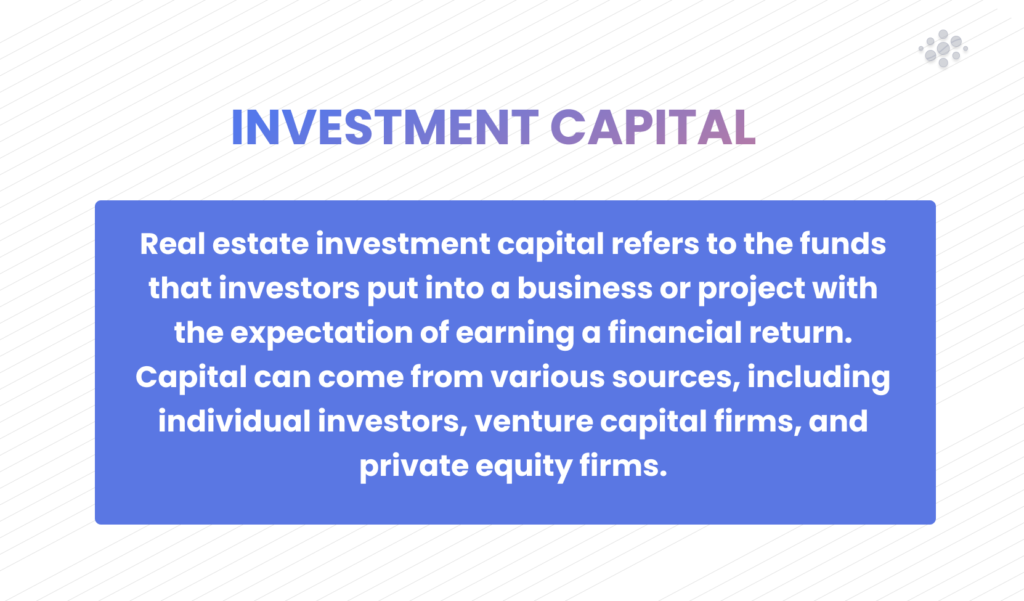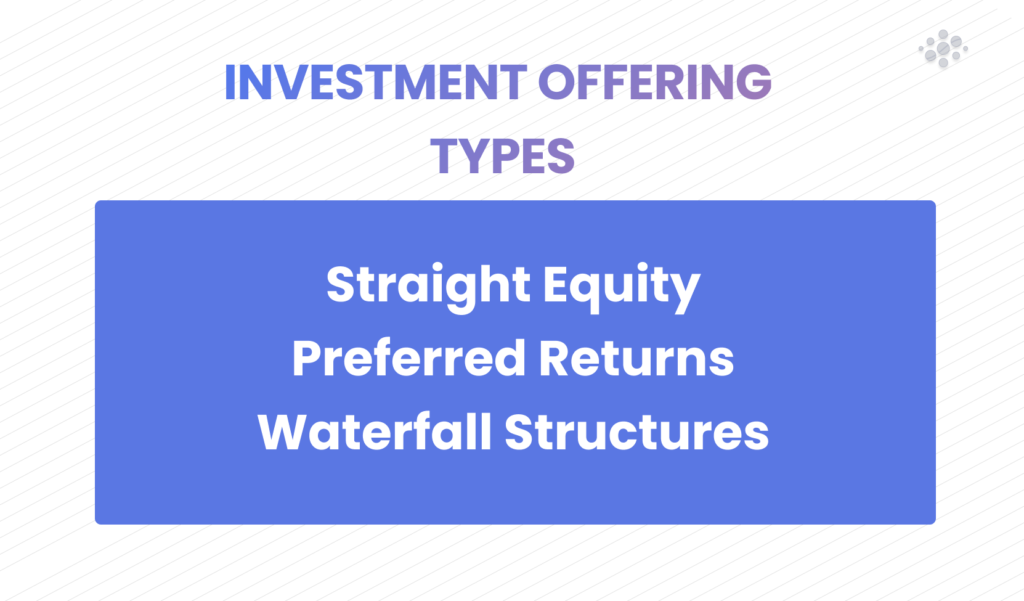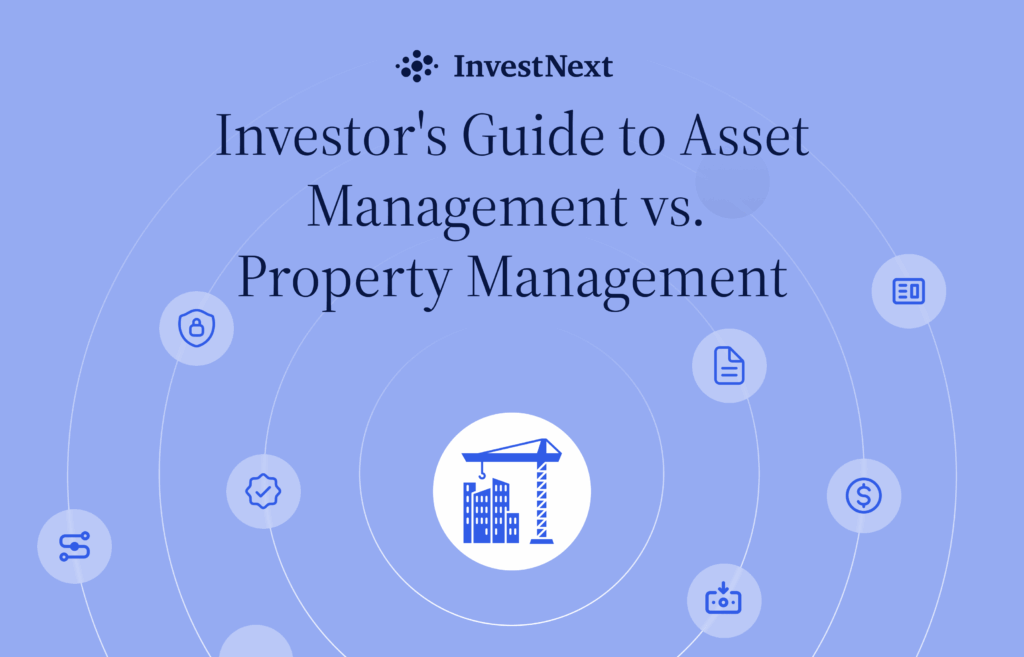When deciding to invest in the largest asset class in the world, one of the challenging aspects of the industry is – #1 raising capital for real estate and #2 convincing investors that you can provide a solid return. Whether you’re a first-timer or an experienced general partner, understanding when and how to raise capital effectively is essential for growth.
In this article, we’ll explore different methods for raising capital, including crowdfunding, syndication deals, and traditional financing options, as well as tips for building relationships with potential investors.

What is Investment Capital?
Real estate investment capital refers to the funds that investors put into a business or project with the expectation of earning a financial return. This capital can come from various sources, including individual investors, venture capital firms, and private equity firms.
The capital raised can be used for a variety of purposes, including starting a new business, expanding an existing one, or funding real estate developments. The investment capital required will depend on the specific project and its goals. For example, a new startup may require a smaller amount of financial support than a real estate development project.
There are two main types of investment capital.
- Equity capital is when an investor invests money into a real estate project in return for an ownership interest. The investor becomes a project partner and shares in the profit and losses. One of the primary advantages of holding equity is that it enables the investor to partake in the appreciation of the property’s value, which might result in substantial profits if the property appreciates over time. However, this also increases the investor’s risk, as they will share in any losses if the property’s value declines.
- Debt capital is capital borrowed from a lender to acquire an asset. When an investor lends money to a real estate project and is repaid with interest, the investor does not possess any property ownership and is only entitled to the interest earned within the loan agreement.
The primary benefit of debt capital is that it is generally considered less risky than equity capital, as the investor is not exposed to any losses if the property decreases in value. However, the returns on debt capital are generally lower than those on equity capital.
Both equity and debt capital have advantages and disadvantages, and the best option for a particular investor will depend on their investment goals and risk tolerance.
How to Source Capital
There are several different sources that a commercial real estate investors can use to raise capital for their projects. Some of the most common sources include:
- Private and Hard Money Lenders can lend to investors at a fixed interest rate and repayment structure. This is similar to a traditional bank mortgage, except the loan term is usually significantly shorter, and a personal credit score is less important. The underwriting in these deals consists of an analysis by the lender of how likely the project is to be successful.
- Self-Directed Accounts adhere to the same guidelines as standard IRAs, except that they are financed by an equity trust and allow the investor to invest in various assets, such as real estate, that are generally unavailable through a brokerage.
- Partnerships are transactional arrangements with two or more parties, each contributing their proportional share of the required equity. The primary benefit of a partnership is that, in return for investing their own money, each partner has direct ownership of the property and a direct say in the decisions needed to manage it.
- Syndication is the most common option for obtaining capital for real estate ventures. In short, syndication is a deal structure where investors can buy a fractional stake in a real estate project without managing it. The “General Partner” (GP) leads the overhead process and handles the property’s financing, management, and acquisition. At the same time, the “Limited Partners” (LP) are individual investors who invest in the venture and receive passive income from the property. This structure can benefit both the GP, who can generate a lot of money and grow their portfolio and the LP, who can benefit from commercial property ownership without the management responsibilities.
- Crowdfunding is of raising capital for projects through small-dollar investments from hundreds or thousands of investors. These online investment management platforms allow investors to invest small amounts of money in a real estate project, such as purchasing or renovating a property.
One of the main benefits of real estate crowdfunding is that it allows individuals to invest in real estate without the need for a large amount of capital or credit. It also provides an opportunity for diversification of the investment portfolio. However, it also carries risks like any other investment, and it’s essential to conduct thorough due diligence before investing.
Deciding on a Deal Structure
When raising capital from investors, deciding on the deal’s structure early on is crucial, as this will vary depending on the approach. Be sure to choose a legal entity with an operating agreement that covers the equity structure, management and operations, voting protocol, books and records, transfers and liquidation, and distributions.
The most frequently used deal structures in commercial real estate are listed below:
- Limited Liability Company: LLCs allow the property to be housed under its entity, separate from personal assets.
- Joint Ventures: are partnerships between two or more business entities.
- Limited Partnership: LPs allow for two classes of investors, active and passive.
- Syndications: In addition to the text above, syndication is a legal entity used for raising capital from third parties, subject to strict rules and regulations. Syndicates can be classified into 506(b) and 506(c), with different requirements for raising money from investors.
Legal Documents and Investment Pitch
When you are ready to start seeking investors, you will need the following materials to provide during your pitch.
- The Offering Memorandum is the legal document that describes the objectives, financials, leadership team, and potential risks of the investment opportunity.
(Click here for further information about Offering Memorandums)
- The Investment Offering is a more detailed description of the project. This document highlights the project’s potential for success by outlining the unique value proposition of the leadership team and the reasons why the project is a worthwhile investment. The Investment Offering serves to inform and persuade investors, encouraging them to consider participating in the project.
- The Proforma shows the detailed financial calculations for the project. It includes specific estimates for all relevant costs associated with the project, including but not limited to renovations, construction costs, and other fees.
Additionally, a Proforma serves as a critical tool for potential investors, as it clearly explains the project’s expected financial returns and demonstrates a well-considered plan for success. A thorough Proforma can instill confidence in potential investors and encourage them to consider investing in the project.

How to Structure Your Investment Offering
There are various options available when putting together an investment offering. The optimal approach will depend on multiple factors, including the level of involvement of each individual invested in the project and the degree of risk tolerance of each participant.
Investment offering types:
- Straight Equity offerings are simple and provide dividends to investors in proportion to their capital contributions.
- Preferred Returns payout preferred investors first, but at a fixed interest rate. The regular shareholders get paid last and may get more or less than the preferred shareholders depending on the project’s performance.
- Waterfall Structures are a way to distribute payouts to investors as the income from the investment increases. In this structure, investors receive payouts in stages as certain financial milestones are achieved.
Lastly, Know Your Investors
Raising capital for commercial real estate projects is a challenging endeavor requiring diverse skills and abilities. Those who excel in this area possess a comprehensive understanding of the real estate process, exceptional emotional intelligence, and communication skills.
An essential component of a successful capital raise is the ability to identify and engage potential investors who align with the investment objectives of the project.
By effectively communicating the investment opportunity to these individuals, securing the necessary funding for the project in return is likely possible.
One effective strategy for identifying potential investors is assessing your network. Friends and family members who have a positive relationship with you can assist or introduce you to other individuals who are in a position to invest.
Additionally, IRA custodians, anyone saving for retirement, may be interested in investing funds from their accounts into a promising project. Furthermore, real estate professionals, both accredited and non-accredited, are always looking for opportunities. Go where they are and introduce yourself – attending local investor meetups and conferences are good networking hubs to try.
Finding investors to fund your commercial real estate project can be challenging, but it is doable with the right strategy. The investors who successfully raise money strategically build relationships with others in the circle or community.
Bottom line
As a sponsor, it is crucial to possess an extensive understanding of the real estate industry and the capital raise process. Additionally, utilizing a robust asset administration tool can facilitate the efficient and effective management of your fundraising efforts and increase the chances of success for your next raise.
InvestNext is a full-service investment management platform that allows you to efficiently oversee all aspects of your capital raise in one place. From same-day ACH transactions to waterfall calculations, impress your investors through an intuitive investor portal coupled with stylish deal room functionalities to captivate, attract and retain investors.
Schedule a demo today to see how our team can help you to welcome the next level of raising capital.



